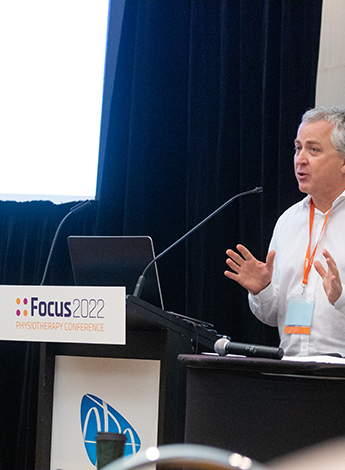
Flexing your business acumen muscle

To run a financially sustainable practice, you need to do more than just pay staff and keep your head above water, says private practice owner Antony Hirst. In this final in a series of three articles on running a successful physiotherapy practice, Antony explains why it is crucial to understand your business’s bottom line.
Every professional development course undertaken by private practice owners to update their professional skills should be matched by a non-clinical course to improve their business acumen, says Antony Hirst APAM.
With experience as both a physiotherapist and a private sector consultant, Antony says it is important to give the same weight to building business skills as you do to professional development.
During his presentation on how to run a successful practice at the recent FOCUS 2022 conference, Antony shared his experiences of grappling with the financial metrics of running a business.
He emphasises that learning about your finances goes beyond the profit-and-loss statement and is key to driving your business forward.
‘I did not qualify as an accountant. My brother is an accountant. He used to make sure that I had a reasonable understanding of everything my accountant produced for me,’ Antony says.
‘You work hard for your money. You should understand the balance sheet in general terms.
‘So every time you do a clinical course, I would encourage you to also do a non-clinical course. Go and look at what the Australian Institute of Management does.
'I’ve been to an accounting conference and it was actually quite interesting,’ says Antony, who is the current chair of the Victorian branch of the APA Business group.
‘They looked at some of the professional services—such as architecture and law—and at how people in those industries pay their staff. You can see how they work and then use that in your own private practice.
'However, if you don’t have a financially sustainable practice, one that can continue to pay staff appropriately, you won’t be providing physiotherapy care to anyone. 'So it’s fairly important to do it right.’
Although profit is a topic that Antony says many physiotherapists avoid discussing, it’s an important marker for private practitioners.
He says that once you engage with the profit of the business, you can begin to separate out, and reflect on, all aspects of the practice more holistically.
‘Most physios in private practice are reluctant to even consider discussing the idea of making a profit. It’s almost as if it’s some unethical word.
'But profit is absolutely fantastic—you can educate people with it; you can donate it if you really wish; you can do great things with it,’ he says.
‘When you assess a patient with chronic low back pain, you look at their range of motion, strengths, ability, neurological condition and lifestyle. You consider their situation in segments and then work out which part of them you need to work on, because you might not need to work on everything,’ he says.

Antony Hirst shared his experiences of grappling with the financial metrics of running a business at the FOCUS 2022 conference. Photo: Michael Blyde
‘Segmenting a business is the same. You can look at different aspects of it to work out which parts are doing well and which parts aren’t.
‘Because even if there are only five segments and you can save only one per cent on each segment, that’s five per cent saved at the end of the year,’ he says.
‘And for those of you who are young and are thinking about getting out in years to come, five per cent of a $1 million practice is $50,000.
‘I often see that owners don’t segment out their business. They also don’t normalise their profit and loss. They look at the first two sheets that their accountant gives them and they get misled.
'You need to look at the reality of your business, not just what’s on your profit-and-loss statements.
'Normalising your business means taking out all the costs that aren’t necessarily reflected in what you’re doing.’
Antony says that private practice owners need to seriously consider the return on the effort and investment they put in. Ideally, he says, in proportion to total income, return should be above 20 per cent.
‘However, 15 per cent would be a good start. So, if it’s a $1 million practice, there needs to be $150,000 in profit at the end of the year. It would be better if it was over 20 per cent. If you’re in the 25 to 30 per cent range, you’re doing very well.
'In my experience, though, the average clinic often runs at about five to six per cent profit.’
In what he describes as a ‘race to the bottom’, Antony says that percentages paid to team members rarely tip in the private practice’s favour, creating an inequitable arrangement that can directly affect the practice’s long-term viability.
‘As a guide, the total professional cost of therapists should be under 45 per cent. I know you’re thinking, “Are you kidding me? I’m paying 55 to 60 already.” That is another discussion about how you’re employing them, because the percentage-based system does kill our industry. People want a greater percentage of more fees,’ he says.
Understanding how to prepare a basic budget for your practice is also key to running a successful practice, Antony believes.
The budget needs to take into account expenditure items such as staff entitlements.
‘Staff often stay for long periods of time and when they leave you are scrambling to find their long service leave entitlements or the many years of holiday entitlements they are owed. This needs to be included in your budgeting.’
Antony also touched on the subject of freehold versus renting a clinic and suggested that if practice owners are considering staying in an area for a long time, they should give thought to buying a property.
‘Banks love lending to people in the health sector. It’s a pretty stable part of the economy and it’s growing.
'And in the long term, when you want to sell the practice, you need to have somewhere secure for the person buying your practice to work from.
'If you own the building, you can give them long-term leases, which is very appealing,’ he says.
‘In the movie The Founder about McDonald’s, they finally work out one day that they were not in the business of making hamburgers or fast food or convenience. They were actually in the business of real estate,’ he says.
‘When we sold a practice, one of the appealing aspects of the sale was that they took a long-term lease on our real estate. So that’s something to think about.’
© Copyright 2024 by Australian Physiotherapy Association. All rights reserved.





